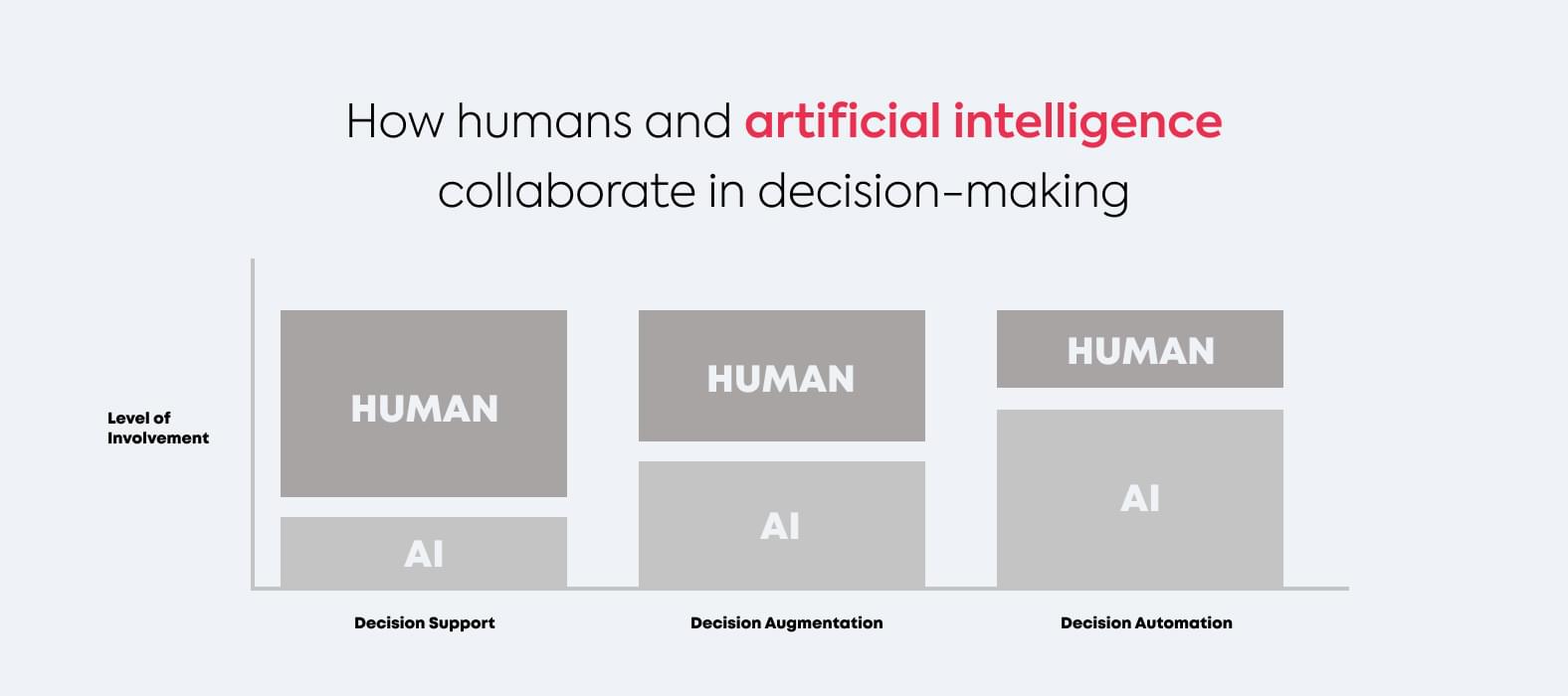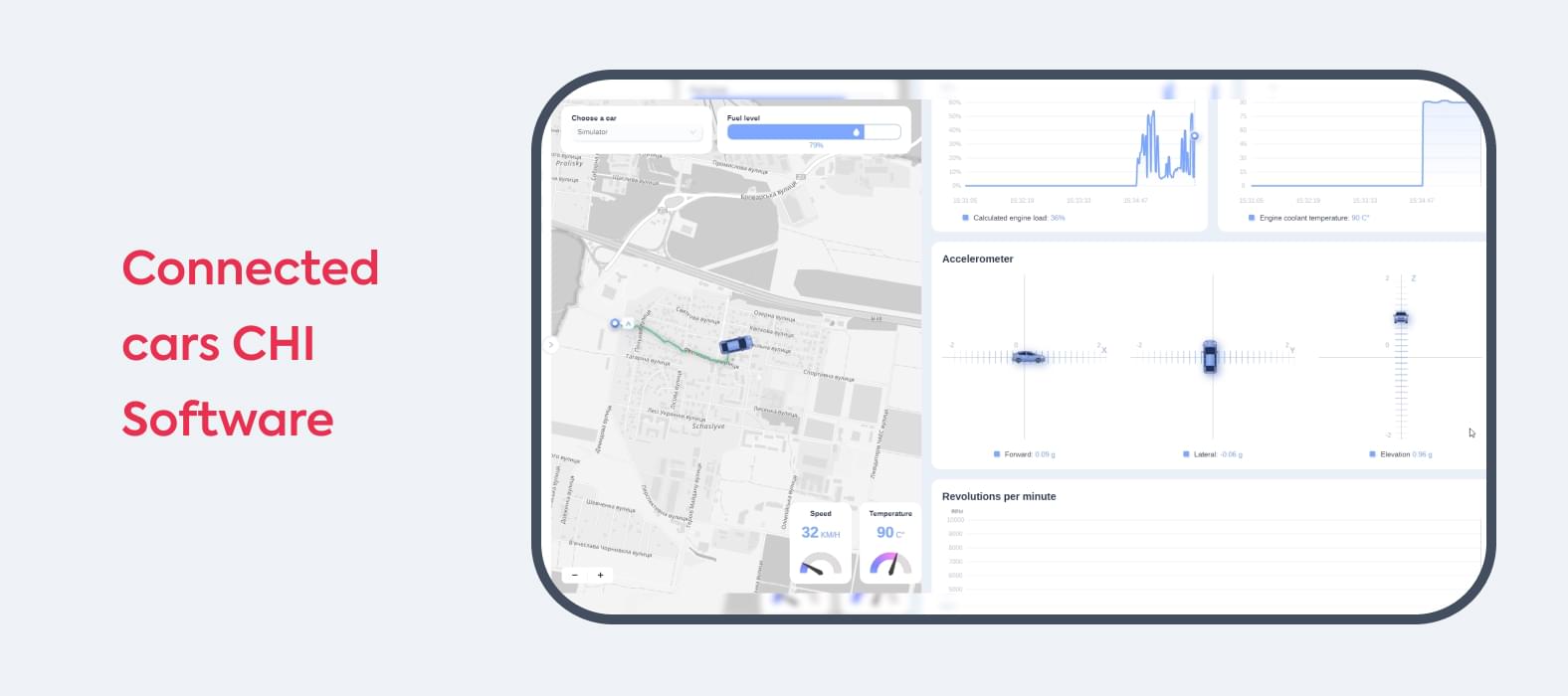We talked a lot about how technologies help businesses to catch every glimpse of customers’ needs. Today I’d like to share about an emerging technology that has already become the Next Big Thing for both businesses and high-technology circles. Let me tell you about Affective AI. The technology development Affective computing exists at the intersection of computer science, psychology, and...
Not so long ago, artificial intelligence was a tricky invention from fiction books and movies. Today, things have taken a different turn, becoming a part of business reality.
We at CHI Software are exploring AI from various perspectives, applying it in numerous domains. In this article, we look closely at AI-based decision-making.
In a Gartner survey, 65 percent of respondents agreed that their decisions now are more complex (involving more options and participants) than they were two years ago. Businesses have to keep up with the high pace of changing market conditions, but they struggle to do it effectively.
Read on to learn how and when to apply advanced AI decision-making. We’ll guide you through basic terms and step-by-step integration instructions. Follow along!
What Is AI Decision-Making?
Let’s start with the essentials. AI decision-making is data processing that is completed fully or partially with the help of artificial intelligence algorithms to establish and maintain positive relationships with customers, target marketing efforts, improve problem-solving, and predict market changes.
Can AI completely replace humans in the business process? It’s doubtful it will happen anytime soon. But for now, company workers and tech innovations can happily coexist in one environment:

- Decision support. This is a starting level of the AI–human interaction. Algorithms provide raw analytical insights by gathering big data sets in a meaningful form, while business employees make final decisions based on their experience, common sense, and market knowledge.
- Decision augmentation. In this form of interaction, the AI system can offer decision variations based on gathered analytics. Employee experience is less crucial to the final decision, so responsibility can be partially shared with the machine.
- Decision automation. AI almost or fully takes over everyday routine tasks and frees up employees’ time for more human-involved activities. It allows achieving maximum consistency in decision-making.
How do humans and AI algorithms differ in business decision-making?
Do you know the speed at which the amount of data around us is growing daily? It’s easier than ever before to generate and transmit any content in seconds. For this reason, corporate data is growing faster than people can process it. They need help. But where should they look for it?
In our current conditions, artificial intelligence in business decision-making gives us the most fruitful results. Humans and technologies are different, but distinctions make their collaboration stronger.
Humans don’t get an overview of every data set. Can you imagine how much time you would spend if you were to analyze at least a hundred customer reviews? And how attentive would you be to each point mentioned there?
We people tend to summarize what we’ve just seen or read, losing smaller details in the process. But as you know, the devil is in the details. We recommend calling for help when your brain is struggling.
Humans have their preconceptions. As soon as any data gets in our hands, we analyze what we think is most important. In contrast, AI has no prejudice and can process aggregates. And here’s an obvious fact: AI doesn’t have any feelings whatsoever. Data is its one and only priority — not what that data depicts.
You may now think that soon machines will conquer the business world. Not so fast — don’t jump to conclusions!
We humans are still more creative with branding strategies, more compassionate with our customers, and more aware of current business reality than AI can possibly be. Humans have created artificial intelligence, and we can gain the most benefit from it.
What Industries Use AI for Decision-Making?

Is there any business out there that has never struggled with decision-making at any point? Hardly any company comes to mind. AI is designed to ease the struggle for many industries, including the ones listed below:
- Finance. AI helps to make decisions about credit applications. Algorithms are able to process the client’s credit score, employment history, proof of income, and other information to decide if they are preferred candidates to borrow money.
- Retail. AI algorithms monitor available inventory and inform employees what products to restock and how many, to prevent extra spending and overconsumption
- Oil and gas. Companies can rely on artificial intelligence to monitor equipment’s performance and quickly decide which instruments need replacement or enhancement.
- Healthcare. Artificial intelligence helps diagnosticians to review visual medical documentation to figure out how severe the cases are. It allows doctors to prioritize their efforts in no time and provide help to the patients that need it the most.
These are only some examples of the limitless opportunities provided by AI innovations. Depending on your business, your ideal solution will probably differ from the use cases implemented on the market.
How Artificial Intelligence Helps in Decision-Making
It’s been years since companies started using the combination of artificial intelligence and decision-making in their daily activities. But how exactly does it look? Let’s review some use cases that are applicable to any industry.
1. Customer Relationship Management
“Marketing’s job is never done. It’s about perpetual motion. We must continue to innovate every day.” — Beth Comstock, Former CMO & Vice Chair, GE
This use of artificial intelligence in business decision-making is one of the most helpful. Following the customers’ needs and changing behavior has never been a simple task. But today, it’s even more challenging. Thankfully, artificial intelligence helps not only to analyze but also to predict the clients’ behavior.
AI algorithms are the most efficient in the online space. Here, they can follow the user’s browsing history and draw up the client’s persona.
Technologies monitor different aspects of the user’s behavior simultaneously and provide a full overview of the changing customer preferences. Marketers get detailed insights that allow them to create unique offerings and decide how much budget to invest in different marketing channels, including TV, radio, and the Internet.
2. Personalized Recommendations
Following the previous point, AI is the best tool for building personal recommendations. Strictly speaking, no one knows your customers better than algorithms.

A recommender system is a solution that follows the user’s history of viewed items and recommends similar products afterward. Such a personalized approach makes people stay on your website a little longer and turns them into your loyal customers later on.
3. Opinion Mining
Analyzing your customers’ reviews and social media mentions can take forever. This analysis never really ends because people keep posting at any time of the day and night. The bigger the company, the harder this issue may strike it.
Smart algorithms can do the work for you by gathering reviews and opinions from all sources and identifying trends (e.g., what users mention most often). It would barely be possible with human-only efforts.
4.Problem-Solving
To have technologies solve issues directly, companies from various fields use expert systems. These are AI-based tools that replicate human-like problem-solving.
The first expert system was created in 1970. It was the first successful AI implementation, as it became “smarter” and more powerful with time. These systems identify and assess information to provide further recommendations for solving particular issues.
5. Pricing Strategy
Another use of artificial intelligence in decision-making is to help you determine product prices. If your managers have to review hundreds or even thousands of product prices daily, they simply won’t be able to do it effectively. But AI can help them.
Smart technologies not only analyze vast amounts of data rapidly, but they also capture price relations that humans may not notice. A price change for some products, for example, may impact the sales of several other items.
6. Business Expansion
Your business is growing, and this is good news. But you don’t know what direction to expand in— and that’s the challenge to deal with. Blending AI and decision-making is a successful use of technologies for this situation.
For example, to decide where to open another branch office, AI analyzes the company’s growth, customer portrait and behavior, and a list of locations. It then offers location variations that are likely to bring the maximum ROI.
How Do You Integrate AI Decision-Making into Your Business?
And here’s the most exciting part. All those examples of decision-making applications in artificial intelligence sound wonderful, but what about your own business? The time for action has come. But before we go any further, ask yourself one question: Are you sure you even need it?
What AI cannot do:
- Generate creative content with no predefined guidelines. Imaginative storytelling of any kind is still only a human capability.
- Coding. To build software, you need developer powers. Software can’t create another software, especially if you need a complex solution with an atypical flow.
- Invent. Only people can create brand-new solutions based on their experience. Yes, artificial intelligence gathers data, but it won’t create something unique with it.
- Be emotional. This point is vital for human-to-human interactions. For example, even if some decision is objectively ineffective, it can make your customers happier, which brings the most value in the long run.
Now, let’s get down to AI integration.

Outline the most troublesome areas
What disturbs you the most needs all of your attention. You should focus on one or two issues to start with.
The task will be easier if you answer these questions:
- Where does your company experience difficulties with decision-making? Think about the departments with the biggest data flows.
- What outcomes do you expect after solving a particular issue?
- What obstacles stop your company from achieving these outcomes?
It’s only three questions, but putting them on paper will already make the situation a little clearer for you.
2. Evaluate your options
The next question to ask yourself is who will do all the work? You should keep your budgeting and management capabilities in mind and act accordingly, using one of these options:
- Buy a ready-made product available on the market that solves issues similar to yours.
- Develop a solution from scratch with the help of your in-house IT department.
- Turn to experienced AI vendors.
- Collaborate with your partner to build a new solution — either in-house or by outsourcing development efforts.
No matter which method you choose, it’s always a good idea to consult an AI tech team. Maybe your case is more complex than you think, or, on the contrary, you don’t need a custom digital product at first but will need it in the next stage of data management.
3. Prepare your data
Now your team should get the documentation ready. Most of the data in the organization is unstructured; in other words, it’s not put in a sheet or a database from which tech tools can easily read and “understand” it.
We’ve prepared a full guide on unstructured data management to help you get through data preparation, storing, and cleaning (checking spelling, analyzing formal and informal abbreviations, removing HTML tags, etc.).
4. Start with your goal in mind
Now, when you’re ready to start, take the AI journey in tiny steps. Having all the expectations in mind, you’ll probably be eager to use all your data right away and wait for a miracle. But instead, consider starting with one data set and see how it works.
Starting small will show you how close you get to your goal and protect you from high organizational risks. If the first attempt is successful, you can gradually expand your efforts and cover the problematic issue in full.
5. Review the results
Think about the metrics that measure your AI achievements. Did you want to correct your pricing strategy? Check how sales numbers change. Did you want to improve your relationships with customers? Check the ratio of positive reviews to negative ones.
There will always be room for improvement. You have to monitor business metrics and be attentive to the most critical issues. Remember, artificial intelligence and business decision-making will work together if you know why you’re using them in the first place.
How Can the CHI Software Team Help You Implement AI into Your Business?
AI is an extremely diverse niche with thousands of applications. At CHI Software, we’ve confirmed that AI algorithms should be implemented, considering specific business goals and market conditions. We offer a variety of ai/ml development services. Check out these use cases.
Price tag tracker
Our client: A big retailer with 500 stores located across Europe.
The challenge: To figure out when it’s time to change product price tags. There are around 5,000 items in every store, and it took a lot of human resources to check if the product price had been changed. What’s more, the retailer bore large losses if price tags changes were delayed.
![]()
Our solution: CHI Software developers were part of a big team creating an AI solution that will decide when it’s time to change the tag and notify store employees about that. It’s a decision automation instrument that helps the business with a routine task.
The solution’s flow is as follows:
- The system collects the tags’ images with CV (computer vision) abilities;
- The system processes data and compares it with the accounting system;
- The CCTV in combination with an AI module detects which tag should be changed in real time;
- The system notifies store employees right away, hastening the price tag change.
The solution’s implementation allowed our client not only to avoid money loss but also to optimize and reorganize personnel workflow.
CV solution for a cosmetics retailer
Our client: A big cosmetics retailer based in Singapore.
The challenge: To decrease customer frustration by providing product recommendations. The retailer has a massive product range but no customer assistance to help make the right choice.

Our solution: CHI Software developers created a CV-based mobile app that can analyze a person’s facial features and recommend the most suitable products. This is a decision augmentation tool, which provides recommendations, but customers make the final decision themselves.
This solution helps store visitors to easily navigate a wide product range and, at the same time, helps the business to increase sales and grow customer loyalty.
Connected Cars X
Our client: A taxi service based in Israel.
The challenge: To gather a full range of data about every car to monitor its overall state and any damages. The business owner needed a tool that allowed him to see the big picture and find out the reasons for a car’s fast deterioration.

The solution: We created a tool that collects data from several sources to provide a full overview of the driver’s behavior and car utilization. Such tools are categorized as decision support solutions as they provide analytics but not recommendations, and humans are fully responsible for the final decision.
All the data is gathered in real time and includes driving scores, trip comfort, vibration levels, optimal speed, etc. The data allows the business owner to negotiate insurance rates and have complete control over his business.
Read more on machine learning in autonomous driving and this use case in our blog post.
Conclusion
Decision-making is a critical part of each working day for managers and business owners, and sometimes, it becomes overwhelming even for the gurus. Luckily, AI is here to help. This is what we’ve discussed today:
- There are three forms of collaboration between humans and AI in decision-making: decision support, augmentation, and automation.
- You can almost fully entrust AI algorithms with daily routine tasks.
- Artificial intelligence is vital for tasks with big volumes of data.
- From finance and retail to healthcare, AI decision-making finds its use in pretty much any industry.
- Artificial intelligence helps to build positive customer relationships by monitoring browsing history and collecting reviews.
- Before starting AI integration, you should define your goal and be sure that AI is capable of doing the job.
- No AI solution will be able to help you if you don’t organize your data beforehand.
- You’ll need at least one consultation with an experienced AI vendor to make things right and use your resources wisely.

Polina is a curious writer who strongly believes in the power of quality content. She loves telling stories about trending innovations and making them understandable for the reader. Her favorite subjects include AI, AR, VR, IoT, design, and management.
